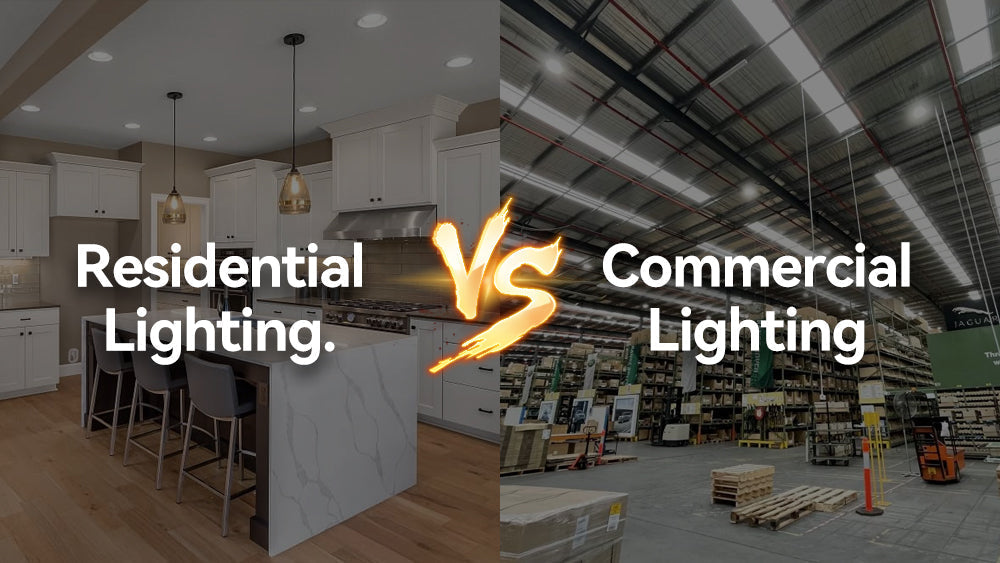Lighting is crucial in how a space looks, feels, and functions, but not all lighting is created equal. Residential lighting focuses on creating a cozy and pleasant atmosphere and aesthetics that suit the needs of individual living spaces. In contrast, commercial lighting is optimized for performance, safety, and energy efficiency, especially in retail stores, offices, and industrial buildings.
Thus, it is necessary to comprehend these differences when designing spaces like homes or shops. In this article, we’ll explore how commercial lighting differs from residential lighting and why making the right choice can improve both function and experience.
What Is Commercial Lighting?
Commercial lighting is specifically designed for high-traffic environments such as offices, retail stores, and factories, with a focus on high brightness, long lifespan, and energy efficiency.
These fixtures are often required to operate for extended hours, sometimes around the clock, and are typically equipped with motion sensors, dimmers, or automated controls to adjust lighting levels based on usage and conserve energy.
In different commercial settings, lighting serves not just for illumination but also for improving efficiency and guiding behavior. In offices, it helps employees stay focused and productive; in retail spaces, strategic lighting highlights products and draws customer attention; and in large venues like malls or airports, it aids navigation and ensures safe movement.
While functionality is the priority, many commercial lighting fixtures now feature clean, modern designs that complement contemporary interiors.

What Is Residential Lighting?
Residential lighting refers to the fixtures used in homes, such as ceiling lights, floor lamps, chandeliers, and wall sconces. These lights are chosen not only for their practical function, such as providing adequate light for reading, cooking, or relaxing, but also for their ability to create a warm and comfortable atmosphere tailored to everyday living.
Unlike commercial lighting, residential lighting prioritizes ambiance and personal style. Many home lighting setups include dimming features, allowing users to adjust brightness according to time of day or activity.
While durability is less of a concern than in commercial spaces, energy efficiency still matters, especially with the growing popularity of LED bulbs. In essence, residential lighting balances functionality with aesthetics, helping homeowners express their personal taste while ensuring comfort and usability.

Key Differences Between Commercial and Residential Lighting
|
Category |
Commercial Lighting |
Residential Lighting |
|
Functional Requirements |
Built for productivity, task support, and large spaces |
Designed for comfort, mood, and home activities |
|
Lighting Intensity & Coverage |
High lumen output for wide, uniform coverage |
Lower lumen output with focused, ambient lighting |
|
Design & Aesthetics |
Prioritizes functionality; design is often minimal |
Aesthetic appeal is central; a wide range of styles |
|
Energy Efficiency Standards |
Strict codes (such as LEED, DLC, and ENERGY STAR) must be followed. |
Encouraged but less regulated for homes |
|
Installation & Maintenance |
Requires professional setup; complex systems |
Easier installation; often DIY-friendly |
|
Safety & Compliance |
Must comply with fire codes, OSHA, and commercial standards |
Follows basic residential codes and local building rules |
|
Cost & Budgeting |
Higher upfront cost, long-term ROI through efficiency |
Lower initial cost, shorter ROI, but fits smaller budgets |
Picking the Best Light for Your Space
Choosing the right lighting depends heavily on the type of space you’re working with. Residential and commercial settings have distinct lighting requirements, and understanding these differences will guide you in making the best lighting decisions.
Below, we break down key considerations for both settings to help you choose the most suitable lighting for your space.
Residential Lighting: Key Considerations
1. Creating the Right Ambiance
In residential settings, the goal is to create an inviting, comfortable environment. To achieve this, soft, warm light is ideal for living rooms and bedrooms, where relaxation and mood-setting are important.
Additionally, layering light sources, such as ambient, task, and accent lighting, helps to create a dynamic atmosphere. Thus, dimmer switches are a great addition, allowing for flexibility in adjusting the lighting to match different activities, from relaxing to entertaining.
2. Choosing Fixtures Based on Room Size
The size of the room directly influences the type of fixtures you choose. Larger rooms, especially those with high ceilings, benefit from pendant lights or chandeliers, which offer broad coverage.
In contrast, smaller spaces opt for focused lighting like table lamps or wall-mounted sconces to avoid overwhelming the room. Ceiling-mounted fixtures like flush mounts or recessed lighting can also provide effective illumination without taking up too much visual space.
3. Prioritizing Energy Efficiency and Ease of Maintenance
While energy efficiency is important for both residential and commercial spaces, it is particularly valued in homes where frequent bulb replacement and high energy bills can be a concern.
That’s why LED bulbs, known for their long lifespan and minimal energy consumption, are an excellent choice for most home lighting needs. Homeowners should opt for fixtures that are easy to clean and maintain, especially in frequently used areas like kitchens or bathrooms.

Commercial Lighting: Key Considerations
1. Ensuring Sufficient Brightness and Uniformity
Commercial lighting is designed to meet functional needs, focusing on uniform brightness and minimal glare. In environments like offices or warehouses, bright and even lighting helps improve productivity and safety.
For large commercial spaces, look for fixtures that provide high lumen output, such as LED high bays or industrial-grade fluorescent lights, to ensure sufficient light levels throughout the area. Task lighting may also be required in specific areas, like desks or workstations, to support detailed activities.
Commercial lighting is designed to meet functional needs, focusing on uniform brightness and minimal glare. In environments like offices or warehouses, bright and even lighting helps improve productivity and safety.
For large commercial spaces, look for fixtures that provide high lumen output, such as LED high bays or industrial-grade LED tube lights, to ensure sufficient illumination throughout the area. Task lighting may also be required in specific areas, like desks or workstations, to support detailed activities.
2. Selecting the Right Fixtures for Different Spaces
The type of commercial space will guide your lighting fixture choices. For retail stores, accent lighting can be used to highlight products or displays, while ambient lighting ensures an overall inviting atmosphere.
In offices, recessed or track lighting can be used to create even light distribution, helping employees focus on tasks without being distracted by shadows or glare. In warehouses or large production areas, high-lumen fixtures and motion sensors are ideal for large-scale lighting needs.
3. Focusing on Durability and Energy Efficiency
Commercial lighting systems are used for long hours and often require high durability to withstand constant operation. LED lights are commonly preferred due to their longevity and low energy consumption.
Additionally, energy-efficient lighting solutions help businesses reduce long-term operating costs. Integrating smart features, such as motion sensors or daylight harvesting systems, helps optimize usage by automatically adjusting lighting based on occupancy and natural light levels.
4. Complying with Safety and Regulatory Standards
Commercial lighting must adhere to safety regulations, including compliance with fire codes and other relevant industry standards. Lighting solutions should be designed with worker safety in mind, providing adequate illumination in emergency exits, hallways, and high-traffic areas.
Ensure that the lighting system meets necessary codes, such as OSHA or LEED certifications, especially for spaces that require special considerations like manufacturing plants or healthcare facilities.
By understanding these distinctions between residential and commercial lighting, you can make informed choices that improve both the functionality and aesthetic of your space. Each setting has its unique requirements, and selecting the right lighting is essential for creating an environment that works for you, whether at home or at the workplace.

Product Recommendations
The 2x4 LED panel light offers an adjustable color temperature feature, allowing users to switch smoothly among warm, natural, and cool lighting to suit various settings. This flexibility makes it adaptable to different commercial environments such as offices, classrooms, or retail spaces.
Furthermore, it includes three selectable power levels (30W, 40W, and 50W), so the brightness can be adjusted according to specific lighting requirements, striking a balance between energy efficiency and visual performance.
In addition, the use of a strobe-free LED light source combined with a durable aluminum alloy frame ensures stability and consistent operation over time. The integrated smooth dimming function enhances brightness control, making it easier to create optimal lighting conditions for different tasks and scenarios in commercial settings.

For Residential Spaces:
The ComiLED 4-inch recessed lighting fixture offers adjustable color temperature, enabling you to tailor the light ambiance to your needs, ranging from soft and relaxing illumination to bright and clear lighting ideal for work. Along with this, the smooth dimming feature provides effortless control over brightness, allowing seamless adaptation to different environments and activities.
Its lampless cup design simplifies installation and fits well with a variety of ceiling types, bringing a modern and clean look to any space. Additionally, the fixture complies with IC certification, which ensures safe use in insulated ceilings and guarantees reliable performance over time. This makes it a practical and stylish option for enhancing comfort and lighting quality in residential settings.

Conclusion
Commercial and residential lighting need to be tailored based on the specific needs of each space if they are to be effective. Each has different fixture types, energy code requirements, and aesthetic preferences. Suitable lighting enhances functionality and adds flair.
At ComiLED, we are experts in state-of-the-art lighting solutions catering to both sectors. Our lighting solutions include fire-rated ceiling lamps along with smart energy-efficient fixtures, which offer maximum protection against hazards while at the same time enhancing the environment’s overall appearance.
Read More
How to Arrange Restaurant Lighting?
A Complete Guide about What is LED Light 2025
What Is the Best Recessed Lighting?
5 Top Things to Consider When Buying LED Spotlights






Partager:
What Is a Can Light Conversion Kit?
Where to Put Floor Lamp in Living Room